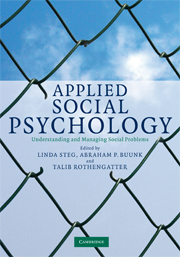Book contents
- Frontmatter
- Contents
- List of figures
- List of tables
- List of boxes
- List of contributors
- Acknowledgments
- 1 Introduction to applied social psychology
- 2 The USE of theory in applied social psychology
- 3 Applications of social psychology to increase the impact of behaviour-focused intervention
- 4 Research designs in applied social psychology
- 5 Social psychology and economic behaviour: heuristics and biases in decision making and judgement
- 6 Social psychology and immigration: relations between immigrants and host societies
- 7 Applying social psychology to the classroom
- 8 Social psychology and environmental problems
- 9 Gender issues in work and organizations
- 10 Social psychology of health and illness
- 11 Social psychology and mental health
- 12 Social psychology and modern organizations: balancing between innovativeness and comfort
- 13 Social psychology and the study of politics
- Index
- References
8 - Social psychology and environmental problems
- Frontmatter
- Contents
- List of figures
- List of tables
- List of boxes
- List of contributors
- Acknowledgments
- 1 Introduction to applied social psychology
- 2 The USE of theory in applied social psychology
- 3 Applications of social psychology to increase the impact of behaviour-focused intervention
- 4 Research designs in applied social psychology
- 5 Social psychology and economic behaviour: heuristics and biases in decision making and judgement
- 6 Social psychology and immigration: relations between immigrants and host societies
- 7 Applying social psychology to the classroom
- 8 Social psychology and environmental problems
- 9 Gender issues in work and organizations
- 10 Social psychology of health and illness
- 11 Social psychology and mental health
- 12 Social psychology and modern organizations: balancing between innovativeness and comfort
- 13 Social psychology and the study of politics
- Index
- References
Summary
Introduction
Behaviour always occurs in the context of a physical environment. In many cases, the physical environment is crucially important to our thoughts, feelings, performance, behaviour and well-being. For example, many people feel uncomfortable in the heat, and are more easily annoyed by others when temperatures are high. Traffic noise may result in stress and cardiovascular diseases. Suburbanization causes people to commute for longer distances. The availability of recycling facilities increases recycling rates. Job satisfaction is higher if employees work in offices with windows that open rather than with windows that do not open. The presence of nature seems to improve health and well-being. Human activities also have an impact on the environment. For example, the use of fossil fuels produces carbon dioxide (CO2) emissions, urbanization reduces farmland and natural landscapes and some species of animals become extinct by human activity. In fact, almost everyone lives in the built environment and many people never encounter an environment that has not been made or modified by human activity.
Environmental psychologists study such interactions between humans and their physical environments. Traditionally, environmental psychologists focused on how the physical environment (e.g., buildings, noise, pollution and the weather) affects us. More recently, much research is directed at the opposite relationship: how we affect the environment, for example, through our energy use, water use, vehicle use and land use.
- Type
- Chapter
- Information
- Applied Social PsychologyUnderstanding and Managing Social Problems, pp. 184 - 205Publisher: Cambridge University PressPrint publication year: 2008
References
- 2
- Cited by



